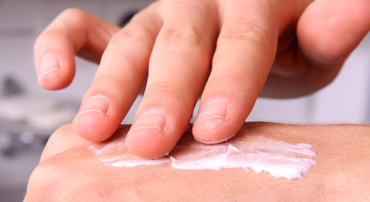Hydrocolloid Technology
Scapa Soft-Pro® Hydrocolloid technology is a type of medical adhesive that contains gel-forming agents, ideal for acute and chronic wounds, ostomy and med device fixation.
learn moreWe are the strategic healthcare and consumer medical device outsource partner you can trust. We collaborate with top global medtech companies to design, develop and manufacture innovative skin-friendly fixation and skin care topical solutions for advanced wound care, consumer wellness and medical device fixation applications. Our competencies include:
.jpg?sfvrsn=b5ae7ed7_2)
Scapa Soft-Pro® Hydrocolloid technology is a type of medical adhesive that contains gel-forming agents, ideal for acute and chronic wounds, ostomy and med device fixation.
learn more
Custom topical wound care solutions and consumer skin care products with the optimal dosage levels of active ingredients and raw materials to achieve premium results.
Learn more
We provide Gamma irradiation services for a variety of medical devices, pharmaceutical and consumable products of different densities, dose requirements and material composition.
learn more
We understand the complexities of wound and ostomy management and all stages of the healing process. Our broad range of technologies and capabilities allow us to deliver unique wound care, ostomy and skin topical solutions to enhance people's.quality of life.
learn more
Today's consumers are looking for products that allow them to address their unique personal care needs from the comfort of their own home. We partner with leading companies to create innovative solutions to address consumers' unmet needs.
learn moreChronic diseases and new lifestyles have led to the adoption of wearable devices to manage overall health with real-time data. Our expertise in medical-grade skin adhesives and advanced materials allow us to develop custom fixation solutions to meet specific end user requirements.
learn moreWound care products like bandages and gauze – often coupled with topicals like antibacterial ointment –are usually sufficient for treating minor injuries like scrapes and cuts. In these cases, the objective is to keep the wound clean and dry it out. However, more complex wounds require advanced wound care (AWC) products, which are usually provided under the direction of a healthcare professional. These types of wounds may include deep cuts and lacerations, puncture wounds, severe blisters, necrosis, and wounds that have become infected. Products used to treat these types of injuries mainly aim to keep the wound hydrated, which has been demonstrated to promote faster natural healing than wounds that are allowed to dry out.
In addition to supporting Moist Wound Healing, AWC products should help maintain a stable temperature around the wound, facilitate oxygen flow (breathability), and protect the wound against contamination and infection. AWC products should also be as gentle as possible upon removal, preventing further pain and harm to the afflicted area.
There are thousands of advanced wound dressing options, so it can be daunting to choose which is best. To start, a clinician will assess the wound and the characteristics of the wound bed to determine whether the wound is too dry or too moist; whether it is infected; whether it is draining excessively; whether it needs damaged tissue or foreign objects removed (debridement), etc.(1) From there, understanding the different characteristics of each category of AWC dressing can help narrow it down.
Advanced wound care dressings commonly include hydrogels, hydrocolloids, films, foams, fabrics, sponges, and alginates.
Hydrogel dressings, for example, are glycerin and water-based and designed with high breathability and cooling properties and can keep wounds moist, which is particularly important for deep wounds and burns. These types of dressings provide excellent fluid handling, cushion the wound, and can be formulated for low trauma removal. Hydrogels are available in gauzes, gels, and sheets.
Alternatively, hydrocolloid dressings contain hydrophilic substances like gelatin, pectin, polysaccharides, or sodium carboxymethylcellulose, that form a gel mass to absorb fluids, dirt, and bacteria. They have low breathability and no cooling properties, but provide stronger adhesion than hydrogels and can provide a good bacterial and viral barrier. These types of dressing can be used to promote autolytic debridement -- using the body’s own moisture and enzymes to liquify necrotic tissue. Hydrocolloids are available in many shapes and sizes and come as wafers, pastes, powders, gels, sheets, films.
Foam dressings are able to hold large amounts of fluid that seeps from the wounded tissue (exudate) and can serve as adhesive or nonadherent multi-layer cavity dressings. Most foam dressings use hydrophilic polyurethane in combination with a hydrophobic backing to protect the wounded area. Silicone-based foam dressings can also be used to protect periwound skin.
Transparent film dressings adhere firmly to the skin surrounding a wound to provide protection without sticking to the wound itself. These are highly flexible for use on challenging anatomical areas and semi-occlusive. This allows the wound to “breathe” and be monitored visually without disturbing the healing process during removal. Films have no absorption properties and cannot manage exudate.
Fabrics and sponges are often used for different types of gauzes. These may be used to hold primary dressings in place (conforming gauze), clean wounds (gauze and drain sponges), or even deliver medications to help in the healing process (impregnated gauze), for example.
Alginate dressings -- made of non-woven fibers derived mainly from seaweed – are highly absorbent and made to manage moderate to large amounts of exudate, but require a secondary dressing to keep them in place.
Chronic wounds can also be treated with Negative Pressure Wound Therapy (NPWT). The NPWT process of drawing fluid or infection from a chronic wound, diabetic ulcer, burn or other severe injury – requires a specialized drape sealed over the wound so a gentle vacuum pump can be attached. NPWT drapes can be used in conjunction with either antimicrobial foams, or higher-density materials.
Some other types of AWC dressing categories include(2):
• Antimicrobials dressings, which come as beads, creams, foams, gels, ointments, pads, pastes, pillows, powders, sheets, and strands.
• Composites, which come in an assortment of sizes and have multiple layers that incorporate a semi- or non-adherent pad.
• Contact layers of woven or perforated material used to line a wound bed.
• Sodium carboxymethylcellulose gelling fibers, available in super-absorbent pads and ropes.
• Silicone Sheets of cross-linked polymers in an assortment of sizes.
• Multilayer systems of specialty absorbents/super absorbents fibers, such as cellulose, cotton, or rayon.
• Wound fillers to help maintain a moist healing environment. These come in the form of beads, creams, foams, pillows, gels, ointments, pastes, pads, powders, strands, or other formulations.
• Many non-adherent wound care dressings can be impregnated with agents and compounds to further promote healing or prevent infection. Agents most commonly used include saline, oil, zinc salts, petrolatum, xeroform and scarlet red.(3)
When developing AWC dressings, characteristics like breathability, adhesion levels, absorption, cooling, repositionability, and sterilization should all be considered. Choosing the right partner for product development is important for AWC applications. Scapa offers a full range of medical grade skin contact adhesives, substrates and technical expertise.
Contact us today to learn more about how we can help you to develop custom advanced wound care solutions and bring them to market rapidly.
________________________________________________________________________
1 Nursing2020, WOUND & SKIN CARE: Choosing a wound dressing, part 1. January 2008, Volume :38 Number 1 , page 60 - 61 Available at: https://www.nursingcenter.com/journalarticle?Article_ID=762247&Journal_ID=54016&Issue_ID=762186
Leave a comment